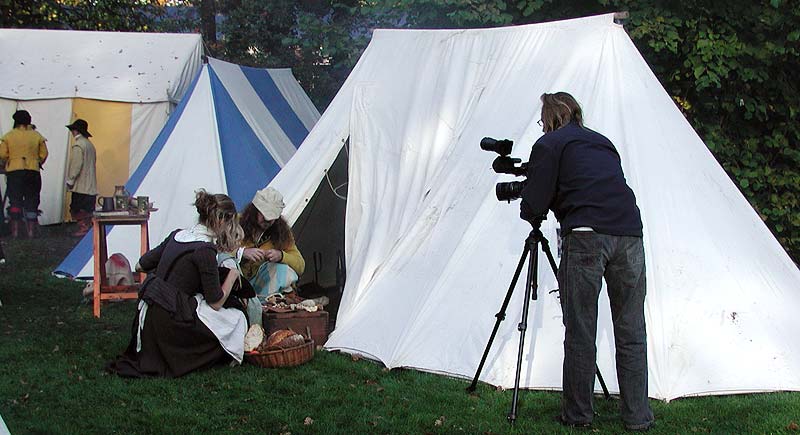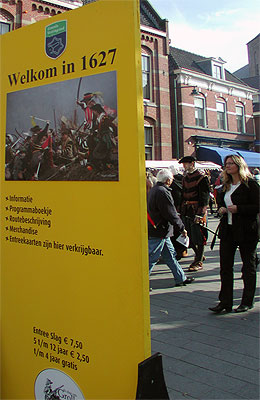
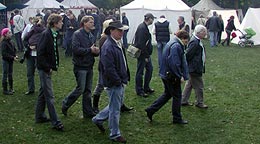
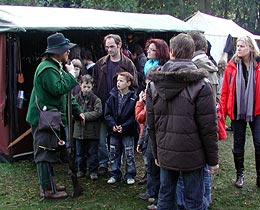
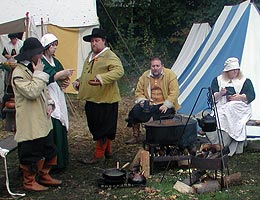
Rawdon's Camp
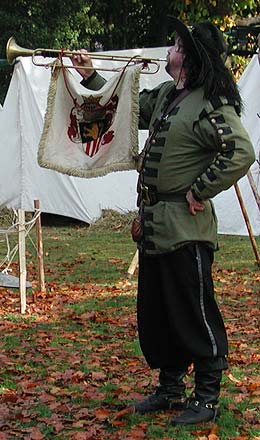
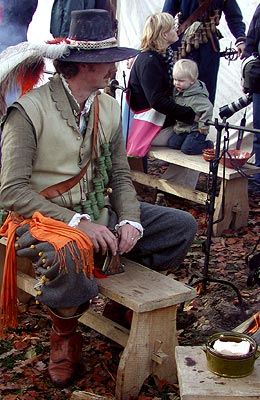
Godfried Nijs, one of the event organizers
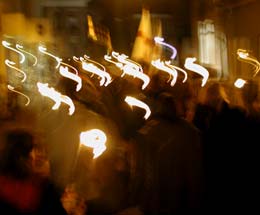
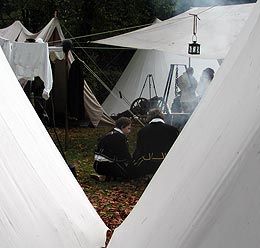
|
Slag om Grolle
17, 18, 19 October, 2008
Groenlo, The Netherlands“Slag om Grolle” is Dutch for “Battle
of Grolle.” The first re-enactment of this was held in 2005, and three
years later, this one. It commemorates the siege in 1627 with the Dutch
and their mercenaries resisting the Spanish-led Army of Flanders in the
latter part of the 80 Years War. There was room for 600 re-enactors, but
more wanted to come and had to be turned down with reluctance. What was
wonderful for the re-enactors (and also for area businesses) was that an
estimated 30,000 paying visitors came, according to a newspaper report.
For the daily battles, we had large crowds watching – and on the final
day got a standing ovation at the end. This re-enactment drew a
considerable audience because the 80 Years War was the crucible from
which the Dutch nation arose (plus many in the audience were German
since the border is only a few kilometers to the east).
I heard five languages among the re-enactors, and there may have been
more. The order of popularity was: Dutch, German, English, Czech and
French, the variety likely replicated the condition in any one of the
many armies of Europe during the 16th and early 17thC.
Living history campsites were throughout the town’s public parks,
with pretty settings among trees and slow waterways.
Participants/campers were approximately divided by language groups. We
English speakers (read: mostly Sealed Knotters) were in one close by
park administration buildings which had the one pair of restrooms with
electricity, showers and flush toilets.
Weeks before the event, I inquired of the Sealed Knot Royalist Regiment,
Rawdon’s, if I could ‘throw in with their outfit' (to use an old Montana
phrase). I singled out Rawdon’s because many in that regiment were at
Bourtange in 2005, which Thorne & I attended, and were going to Groenlo
in numbers. They generously agreed and even provided me a ride to the
Netherlands from London via the “Chunnel” plus a spot to roll out my
sleeping bag in their area in living history. Best yet, they accepted me
with cheer, a place at the campfire, earfuls of good stories and the
bottle as it was passed around – despite me being a Parliamentarian.
Rawdon’s Regiment is one unit in the Hopton’s Tercio of the Sealed Knot.
Members of other regiments in that Tercio came, too, Godolphin’s and
Slanning’s. My blue-gray Stamford’s coat blended well with the coat
color of Slanning’s. The Colonel for Hopton’s led us all. A Sealed Knot
Parliamentarian regiment, Manchester’s, was in attendance, but I knew no
one in that.
I along with two Rawdon’s musketeers slept in the capacious supply tent
at the back of the Rawdon’s camp. On the topic of sleeping, I stretch
out on the ground at events, as many of you know by now. The first night
in Groenlo, heaps of straw were made available. A couple of Rawdon’s
persuaded me to try the straw (it was, after all, past mid-October in
northern Europe). I arranged a thick pad under my sleeping bag. Both
insulated and padded, I scrunched my body into the straw to form
contours - never before have I slept that well and that comfortably in
my sleeping bag than I did there. Straw was sleeping luxury!
Being living-history campsites, those 30,000 visited and viewed in
droves. During ‘business’ hours, we had to remain in kit and keep the
site appearing period, including eating period food with period
utensils. Members of the public, though, were not held back by perimeter
ropes or any sort of barriers; they were free to stroll right up to the
campfire, and they did. That did not result in any problems because the
visitors were impeccably polite, poking about with only their eyes. Some
did pose questions, and they understood our answers because most Dutch
(and many Germans) speak English sufficiently to fluently.
At times, especially in the mornings before the official daily openings,
camera crews with actors made use of the living history and re-enactors
in kit for background. They were shooting video for a large, interactive
display to be set up in the town this winter, and a Dutch organizer said
there was interest by other Dutch and by Germans in the video footage
for documentaries, for one, on the Thirty Years War. One video sequence
taken in our camp was of a young woman carrying a basket of bread and
set upon by two rude soldiers who try to steal her bread.
When time permitted, I strolled around the living history sites in other
park areas. The Dutch had theirs next to one of the old moats of the
original fortification. Most of their setups were very, very realistic,
even to tree limbs for tent poles. There were in other parks Germans,
some of whom with sharply detailed and accurate camps. Two tents,
however, had metal stovepipes protruding out their backs, and the piping
was obviously modern era of rolled and galvanized steel. One detail in
two different camps (Dutch and German) that grabbed my eye and made me
stop to admire was tanned wild-boar hides (with hair left on) draped
over chairs.
Not wishing to impose anymore than I had to upon my congenial host
regiment, in kit, I struck out on my own for breakfast. The first
morning, nothing visibly open, a group of Germans also in kit knocked on
a restaurant window. The proprietor obliged them by opening right then
and I followed them in. As I sat myself at the bar, the Germans invited
me to their table - I cheerfully accepted. Although they conversed in
German and my skill with that language is sketchy, I nevertheless
enjoyed myself. In English, I inquired from where in Germany did they
come. Response: Bavaria, which one described as being “near Germany.” I
joined them again the following two mornings and made mostly futile
attempts to grab at the meaning of their words volleyed back and forth.
The town itself was ornamented with 17thC touches, like old wagons,
barrels, tools, thick logs, wood chips and so forth, which set an appropriate
ambience. On two of the nights, we re-enactors held torchlit
processions, the supplied torches being wax-impregnated columns of fiber
on sticks. The line of marchers arranged by regiments/units, we wound
through the town along a predetermined route by the light of about 100
little torches. Hundreds of spectators crowded the procession route.
Rawdon’s Regiment was near the front and followed what may have been a
Czech regiment, which did a little step to each side when stopping. What
next came was not in the program. Seeing that cute little step, Rawdon’s
broke out in song: “Let’s Do the Time Warp Again,” from the Rocky
Horror Picture Show. One loud song naturally had to follow another
and we sang during the course of the procession, some songs period,
others somewhat not.
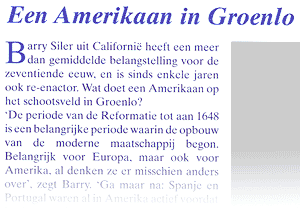
A program booklet had a page on little ol' me |
Prior to the second night’s procession, the Dutch hosts provided a
free banquet of period food. Accompanying the meal were chits for four
free beers per re-enactor. This event coincided with the locals’ annual bok-beer celebration, and that bok beer was sumptuous. (Plus, when we’d
arrived Thursday night, each of us were then given four other tokens for
free beer – and 50 euros, supplied by a government ministry to encourage
historical events – my 50 euros went right back into the local economy.)
On each afternoon of the three days was the big battle, held a short
walk outside Groenlo and watched by a great crowd of spectators. Before
each battle, regiments assembled in the town square and down one of the
main streets. Assemblage required time, which harkened the old military
maxim: “Hurry up and wait.” While waiting, we had on each side of the
column of re-enactors a thick throng of visitors. I was a bit amazed at
their patience as we stood and stood and stood. A pikeman in
Godolphins’s, who was fluent in German, singled out young boys (and some
girls) in the audience for two-minute lessons in swordsmanship. He lent
each a heavy, infantryman’s sword, not one of those slender epees, and
even let each wear his helmet. The children thought that was too
wonderful to be real. The parents were even more happy - out came
cameras.
After we were all well assembled and waited, we 600 re-enactors marched
out to the battlefield, each regiment maintaining its files and ranks,
weapons shouldered, drums rolling, flags swirling.
Three days of battle - on an unusual field of honor |










